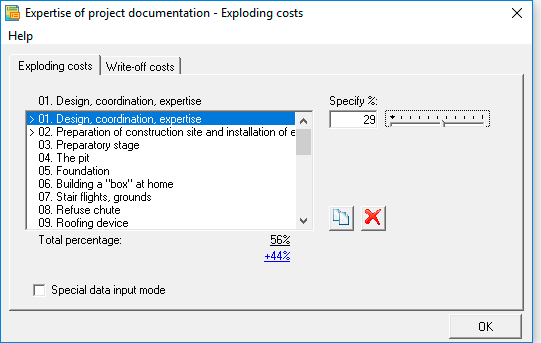Production plan. The attribution of costs for the article "stocks", capitalization of costs. The method of allocating costs to processes or products
In this section we will analyze examples of accounting for the capitalization of costs (attributing them to the cost of non-current assets). You will learn how to show capitalization or allocation of costs to inventory in a business plan, and why in some projects accounting for capitalization affects the parameters for calculating performance indicators.
Costs increase the value of the asset over several months (for example, in construction projects), that is, they are capitalized by including them in the cost of this asset - before the facility is put into operation.
In both cases, Budget-Plan Express uses a special interface in the form of editing “Write-off of costs” - both for the case of assigning costs to inventories and for capitalization (attribution to the value of assets).
The attribution of costs for the article "stocks", capitalization of costs.
When Contracting for projects consisting of several phases, where the execution of the contract may be delayed, transferred to other tax periods, financial officers often use schemes of temporary assignment of costs to inventories, where the "reserves" are accepted costs (used resources) for the implementation phases of the project. This allows to some extent to reduce the risks from uncertainties related to the tax accruals (deductions or payments). In this case, "reserves" are written off to costs at the end of the project (or stage) and, consequently, in the same period are recognized in "profit and loss".
Budget-Plan Express is a software product for preparing business plans and presentations in Word and Excel format, optimal for small businesses and studies (for students, graduate students, MBI students, etc.)
Build a financial model for your project using the Gantt chart! Try the new version of the program (6.02). Details ...
In other cases, costs increase the value of the asset for several months (for example, in construction projects), are capitalized by including them in the value of this asset. In either case, the "Budget-Plan Express" uses a special interface in the form of editing "Write-off costs". To call up the editing form, click (one click) on the active link ... Plan using the editing form, see the following examples.
An example of assignment of costs to inventories
Consider the algorithm for assigning costs to "stocks" using the example of the implementation of the stage in the project: "Examination of the project documentation" (the stage is highlighted in color).
Production plan – infographic includes the following steps (tasks) of the project:
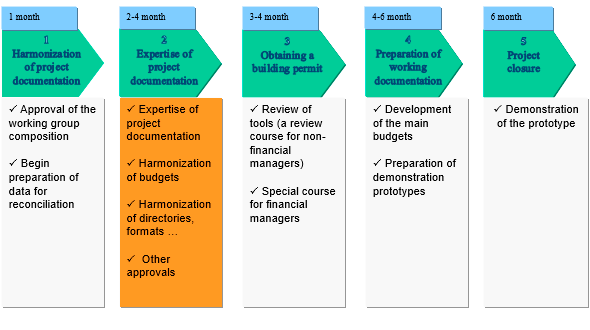
After the planning stages of production in the Gantt chart, perform the calculation of the plan of implementation costs stages of manufacturing: "Data → Calculate → Gantt chart or outline of production costs (run simultaneously)". Same F9.
A fragment of the calculation of plan costs for implementation of stages of production
(see line [2] – Examination of project documentation):

After calling the edit form, select or clear required check boxes (one click). Also, use the buttons "install", "remove" check boxes and "copy settings for subsequent cost":
-
[+] – when you press the flags are set respectively for the 1st, 2nd and 3rd year.
[-] – when pressed, clears all check boxes.
[Copy] – when pressed, the current settings are copied to all subsequent costs.
Example of setting up an interface in the form of editing - tab "Write-off of costs":
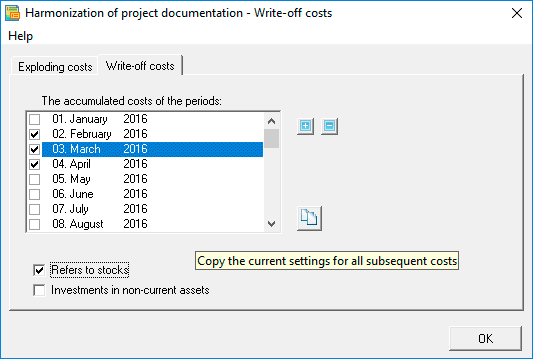
 Assigning costs to stocks - by steps:
Assigning costs to stocks - by steps:
- step . Call the form and select the "Write-off costs" tab.
- step . Select the check boxes (click of the mouse) during periods of accumulating costs on "stocks". The checkboxes are set continuously : the period of the first canceled flag the algorithm of the program "considers" the period of write-off of inventories for costs.
- step . Select the checkbox for inventory.
 If the Check for Inventory checkbox is not checked, the program algorithm ignores this procedure.
If the Check for Inventory checkbox is not checked, the program algorithm ignores this procedure.
Accounting cost stage of "design documents" in the budget plans:
| Accounting for the cost of a resource - an indication of the plan and articles | Jan (15) | Feb (15) | March (15) | Apr (15) | May (15) | June (15) |
| Plan production costs. Examination of project documentation | 0 | 50 000 | 40 000 | 50 000 | 10 000 | 0 |
| Profit and Loss statement. Direct costs | 0 | 0 | 0 | 0 | 150 000 | 0 |
| Balance of Reserves (accumulated resources) | 0 | 50 000 | 90 000 | 140 000 | Write-off of an asset | 0 |
In the example, the project is supposed to last 4 months, where "May" is the last month of the project. Costs are accumulated on reserves for 3 months (February, March, April). Costs in May increase by the amount of written-off inventory (10,000 + 140,000). As a result, in May the project is completed, the costs for the result are written off, and in the same period the expenses are taken into account in the "Profit and Loss Statement".
Example of capitalization of costs (included in cost of non-current assets)
To take into account the capitalization of costs (assigning them to the value of non-current assets), for example, in construction projects, a similar calculation algorithm is used: the program searches for the first check box, and then includes all costs in subsequent periods in the value of non-current assets.
☛ Note that the program algorithm takes into account one cycle of cost production, including the beginning and ending (before the first canceled flag).
In this case, the "investment in non-current assets" flag must be checked. After the set up of the settings and the calculation of the balance sheet, the corresponding costs will be included in the total assets value by the cumulative total - up to the "commissioning" period, where they will be written off for sales. In other words, the algorithm for calculating "write-off of an asset" corresponds to the operation in the accounting record - "commissioning of the facility" (debit 86, 62 - interest holders and other buyers, loan 08 - construction).
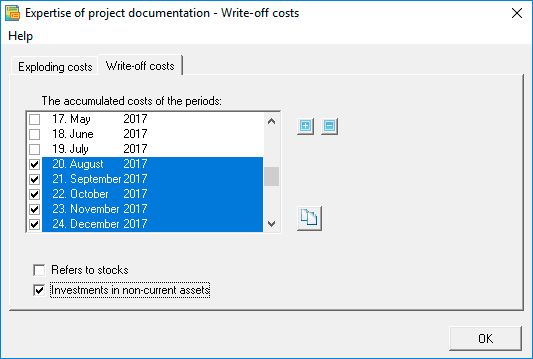
In the above example, presumably, the accumulated costs increase the cost of construction of the object until "October 2017", where in the following month of the project – input of object in operation.
To edit the checkboxes, also use the "setup" and "unset" buttons, to copy the settings, respectively - "copying settings for subsequent costs":
-
[+] – when you press the flags are set respectively for the 1st, 2nd and 3rd year.
[-] – when pressed, clears all check boxes.
[Copy] – when pressed, the current settings are copied to all subsequent costs.
Output of the message after pressing the button "copying settings for subsequent costs":
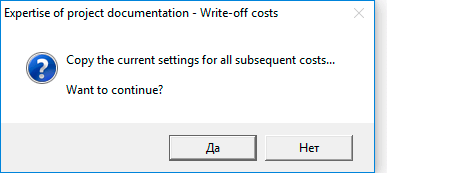
Why in the program all costs, including targeted financing, are included in the "Profit and Loss statement"?
Capitalization of costs (in construction projects) is that the costs that incomes will incur in subsequent periods are not reflected in the composition of the income statement but as part of the asset or liability of the balance sheet. For this reason, capitalization distorts the financial result. In business planning, this approach is not acceptable, therefore, for planning purposes, capitalization of costs is always included in the income statement.
When reflecting costs in construction projects, a number of additional questions arise. On the one hand, capital investments are investments in fixed assets (fixed assets), on the other hand, they are investments in non-current assets and are accounted for as long-term investments.
It would be incorrect in the financial result to reflect only the result of the transfer of the construction object (developer's remuneration), which would contradict the principles of IFRS.
Thus, in the statement of profit and loss revenue and cost should be reflected in full, including targeted funding and remuneration of the Builder.
☛ If you find it necessary to change the name of the table or rows, use the "translit".
Distribution of costs in the "production plan" by products
The procedure "Distribution of costs by products" adjusts the costs in the "report on products", where they are recorded as part of direct costs. Similarly, the form of cost adjustments is used in the "Plan fixed costs" table.
The cost allocation method includes the principles of the ABC / ABM methodology (Activity Based Costing / Activity Based Management), which clarify the cost estimates when referring directly to processes or products. Here (in the "Budget-Plan Express"), it is mainly about costs (direct and variable), which are not directly included in the cost of products. The percentage-based estimates in this methodology are resource drivers.

Distribution of costs by products - by steps:
- step . Activate the form - the "Expense costs" tab;
- step . Select from the list of necessary products and indicate the percentage of costs for this product - in the field, or with the help of the "runner". For the convenience of data entry, you can use the "special mode", as shown in the figure (check / uncheck).
The form of "Distribution of costs by products":
